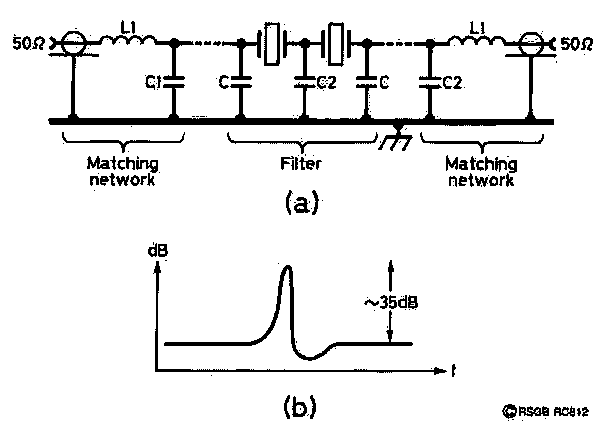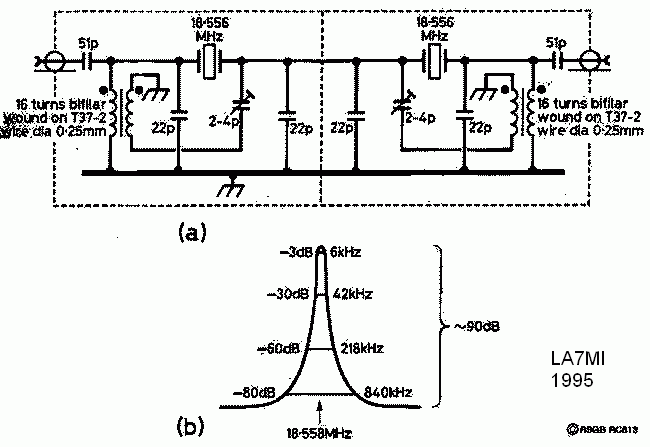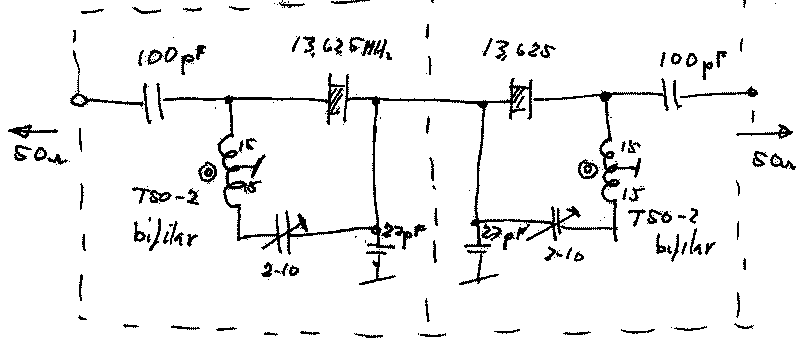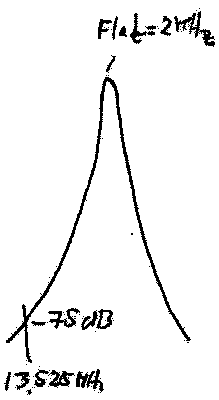
n23 Lowcost xtal filters

n23 Lowcost xtal filters
Improved stopband of crystal ladder filters
Stein Torp, LA7MI, has found a relatively simple way to increase
greatly the stopband attenuation. One result would be to provide
an effective roofing filter in double-conversion receiver, but
the technique could also be applied to narrow-band filters using
three or more crystals.
LA7MI writes: My experiments were carried out with fifth harmonic
92.8611MHz (HC18/U) xtals. At their fundamental frequency
(18.556MHz) they were free of spurious responses and I first
constructed a simple ladder filter at that frequency. The
stop-band attenuation was 35dB, which is about usual for such a
filter

Fig 1a LA7MI's prototype two-crystal 18.5MHz ladder filter.
Fig 1b: Approximate shape of the response curve showing a
stopband attenuation is only about 35dB.

Fig 2a. LA7MI's improved two-crystal 18.5MHz crystal filterwith
the crystal capacitance neutralised.
Fig 2b. Response curve showing a stop-band attenuation of almost
90dB. Such a filter would make an excellent low-cost roofing
filter.
To build a better filter I first modified the matching network.
L1 was replaced by a 51pF polystyrene capacitor. C1 was replaced
by an inductance wound on an Amidon T37-2 toroid core. By using a
bifilar winding and a 2-4pF ceramic trimmer the internal
capacitance of the crystal (approximately 3.8pF) can be
neutralized. After careful screening, the stopband attenuation is
now close to 90dB which is the limit of measurement with the
HP8505A Network Analyser. The passband is more symmetrical
compared to the original unneutralized filter, insertion loss is
only 1.5dB
G3VA, Technical topics, pg 71 December 1995

Fig 3a) Similar xtal filter for 13.5MHz.
Uses xtals which are free from spurious resonnances, possibly
overtone xtals on fundamental frequency.
Stopband attenuation is 80-90dB and insertion loss is less than
2dB. Good screeing is important. Reflection loss is better than
20dB
on center frequency, but drops to 10dB on the edges.
It is an unwanted passband on harmonic freequency, so a
lowpassfilter is required. (LA7MI 2004.10.05)
Type components: T50-2 (2x15 turns bifilar wound), 13.625MHz
xtals, 100pF, 27pF, 1-10pF trimmers

Fig 3b) Passband.
 |
 |
4) Lowcost filter on 9MHz using 27MHz CB xtals.
Many years ago I bought very lowcost CB xtals in Germany.
When I measure the xtals, I find that there are false resonnances
above the rated frequencies in 27MHz band. But the 9MHz filter
has a reasonable clean curve without important false resonnances
above 9MHz. I wondered why the insertion loss was over 10dB, but
after measuring the xtals it turned out that the xtals has a
series resistance of 100 ohm. It is far more than the xtals I've
used in previous filters, so these CB-xtals have lower Q-value.
<LA7MI 2004.11.25>
About terminating mechanical filters, see page c12
Most topics are received in letters from LA7MI.
He has a soldering iron, but no email, and is reached by
telephone nr +47-55-902392.
He will be very pleased to receive
comments, the postal address is: LA7MI Stein Torp,
Tollbodalmenning 34, N-5005 Bergen, Norway
Last update: 2004.11.27